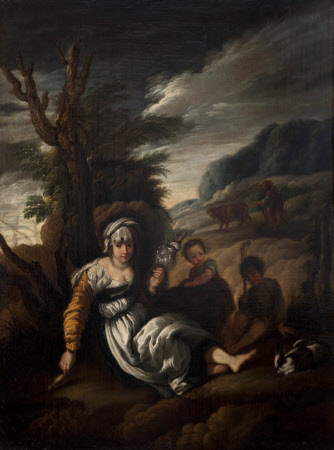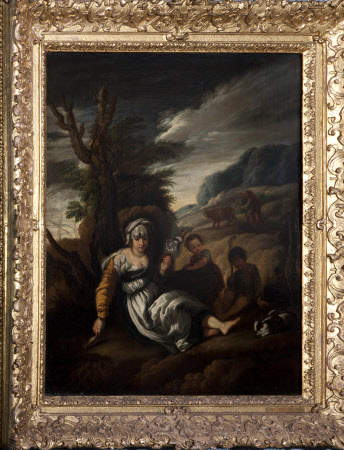‘La vie champêtre’ (Adam and Eve after their Expulsion from Eden)
possibly Domenico Fetti (Rome c.1589 - Venice 1624)
Category
Art / Oil paintings
Date
1600 - 1629
Materials
Oil on canvas
Measurements
940 x 1448 mm (37 x 57 in)
Place of origin
Italy
Order this imageCollection
Kedleston Hall, Derbyshire
NT 108847
Summary
Oil painting on canvas, ‘La vie champêtre’ (Adam and Eve after their Expulsion from Eden), possibly by Domenico Fetti (Rome c.1589 – Venice 1624), early 17th century. Young woman, full-length, seated on the ground beneath a tree, turned three-quarters to right, gazing at spectator, holding a spindle in her left hand, her legs outstretched to the right, dressed in 16th century peasant costume and hat with fringed cloth hanging on brow; two young children to the right in the middle foreground, behind them in the middle-distance is a man , full-length, turned to left, following an ox holding a plough., distant hills to right, skyscape to left and centre. Fetti spent almost his whole career in the service of Ferdinando Gonzaga, Duke of Mantua. His most characteristic works were small scale pictures of the Parables. The present picture illustrates Adam and Eve compelled to toil and spin, with their two sons Cain and Abel. A young woman (Eve), full-length, seated on the ground beneath a tree, turned three-quarters to right, gazing at spectator, holding a spindle in her left hand, her legs outstretched to the right, dressed in 16th century peasant costume and hat with fringed cloth hanging on brow; two young children to the right in the middle foreground, behind them in the middle-distance is a man (Adam) , full-length, turned to left, following an ox holding a plough., distant hills to right, skyscape to left and centre. There are superior versions in the Louvre and the Courtauld Institute.
Provenance
Ferdinando Carlo Gonzaga, 10th Duke of Mantua (1652-1708), recorded in the 1665, 1706 and 1709 Gonzaga inventories; Louis Prosper Bauyn, sieur de Cormery, known to his contemporaries as Biberon de Comery, Paris, (b.1684); duc de Tallard; Dr Robert Bragge;sold by Dr Robert Bragge at a sale in London in March 1753 and bought by John Barnard. (Sale recorded in Houlditch and Houlditch, “Sale Catalogues…”, I, p.313: “69. A Woman Spinning &c…. D. Feti [£]38 6-6. Barnard);recorded in John Barnard’s House, Berkeley Square: London and Environs, vol.I 1761 (no. 53) & Martyn, vol.I, 1766;acquired from John Barnard; recorded in Kedleston in 1766; John Barnard (his monogram and the number 53 are on the back), and recorded in the Withdrawing Room in 1769;and thence by descent until bought with part of the contents of Kedleston with the aid of the National Heritage Memorial Fund in 1987 when the house and park were given to the National Trust by Francis Curzon, 3rd Viscount Scarsdale (1924-2000)
Credit line
Kedleston Hall, The Scarsdale Collection (acquired with the help of the National Heritage Memorial Fund and transferred to The National Trust in 1987)
Marks and inscriptions
Recto: DOM FETI 1589-1620 (label, punched and painted, botton rhs of frame, black text on gold) Verso: Back inscribed with number JB N: 53 the monogram of John Barnard
Makers and roles
possibly Domenico Fetti (Rome c.1589 - Venice 1624), publisher
References
Russell 1987 Francis Russell, “Securing the future: pictures at Kedleston Hall, Derbyshire.” Country Life, 23 July 1987, pp.96-99 Eidelberg & Rowlands 1994 Martin Eidelberg and Eliot W. Rowlands, ‘The Dispersal of the Last Duke of Mantua’s Paintings’ Gazette des Beaux-Arts, May-June 1994, pp.218-9

